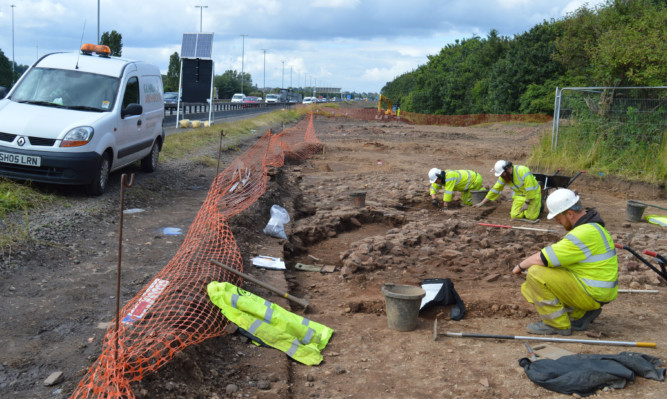A “lost” Scottish village has been found after the discovery of coins and artefacts possibly dating back 1,000 years were unearthed during motorway construction works.
Archaeologists also found what is believed to be 14th-century medieval pottery, gaming pieces and fragments of a clay smoking-pipe on the site of the former village of Cadzow in South Lanarkshire.
Construction workers made the initial discovery while expanding the M74 motorway and called in a team of archaeologists to advise them on how to preserve the site.
The medieval village of Cadzow was renamed Hamilton in the 15th century in honour of the lord of the area and the settlement moved south to the current location of the town.
The remains of two ancient stone structures were also found during the excavation, which experts believe could have been a religious shrine more than 1,000 years ago.
While Cadzow was left behind and deteriorated over time, Netherton Cross – a major religious monument erected in the village in the 10th or 11th century – remained and was relocated in 1925 to the grounds of Hamilton Parish Church to preserve it.
The two structures unearthed lie adjacent to a memorial stone marking the original position of the Netherton Cross.
Kevin Mooney, project director for Guard Archaeology, which oversaw the excavation, said: “It is believed one of the structures was literally on the position of the Netherton Cross and there is a possibility that one or other of these buildings may have had some religious connection, although further analysis of the artefacts may shed some light on this.
“We are not sure of the age of these structures just yet, however the Netherton Cross dates from the 10th or 11th century, therefore it is possible that the surrounding buildings could date from the same period – so we could be looking at a site and artefacts that are 1,000 years old.”
Nine medieval coins were found during the excavation.
Mr Mooney added: “It is very unusual to find so many coins in one place. We think it’s possible that people thought it lucky to leave a coin at the religious shrine.”
The discovery was made on the verge of the M74 motorway near junction 6 Hamilton, where the carriageway is being widened as part of a £500 million project.
Infrastructure minister Keith Brown viewed the findings on a visit to the site.
He said: “The discoveries on the M74 near Hamilton, which could have remained uncovered had works not started, are truly remarkable and underline the importance of the value we place on meeting our environmental obligations as we plan and construct essential new infrastructure.”
